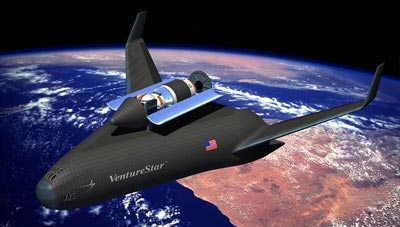Is there a business case for RLVs?by Jeff Foust
|
| VentureStar would have cost far more to develop than any commercial jetliner, yet would serve a far smaller market. |
These technological issues mean that building an orbital RLV will be an expensive prospect. Some reports suggested that the full cost to develop VentureStar would have approached $35 billion. If this figure seems outlandish, keep in mind that current estimates for the Orbital Space Plane—a vehicle that is essentially only a reusable human-rated upper stage for an expendable launcher—range from $10 to $20 billion. Even if VentureStar’s putative price is cut in half, it still requires a sum greater than what it will cost Airbus to develop the A380 ($10.7 billion) or Boeing to develop the 7E7 (between $7 and 10 billion). Unlike the launch industry, the aviation industry is considerably more mature and understood, yet analysts believe that each company is betting its future on these new aircraft. If spending that amount of money (even with some degree of government subsidization) in a mature industry is considered risky, spending an even larger amount on launch vehicles borders on the insane.
Even if an orbital RLV is developed (most likely through heavy government subsidy), it faces the challenge of making a profit. For RLVs to be cost-effective, they must have a high flight rate. An RLV, like an airliner, makes no money sitting in a hangar. The hope in the industry has been that a RLV with low launch costs would generate considerable additional demand for launches. The latest research, though, indicates that this is most likely not the case.
| According to the ASCENT study, cutting launch costs by a factor of four increases launch demand by less than a factor of 2.5: in other words, less revenue despite more launches. |
The most quantitative study of the effects of low-cost space access on launch demand is the Analysis of Space Concepts Enabled by New Transportation (ASCENT) study, completed earlier this year by the Futron Corporation under a NASA SLI contract. The report examined how demand for space access would change as a function of launch costs for a wide range of markets, from communications to remote sensing to tourism. The study took a neutral approach to both markets and launch vehicle technology, with no effort to advocate either a certain class of markets or specific launch vehicle technologies.
“The dose of pragmatism produces some sobering outlooks,” notes the report’s executive summary. In the absence of an RLV launch demand remains relatively flat, at about 60 to 80 launches a year through the end of the forecast in 2021. Moreover, reducing launch costs does not stimulate a huge increase in launch demand, as many industry sectors, particularly established ones like communications satellites, have remarkably inelastic demand curves. Introducing a vehicle that reduces the cost of space access by 75% increases launch demand only from about 60 in 2001 to under 140 in 2021. In other words, cutting launch costs by a factor of four increases launch demand by less than a factor of 2.5. It doesn’t take an MBA to realize that such an RLV would generate less revenue than existing expendable vehicles, making it very difficult to pay off the huge investment required to develop such a vehicle.
